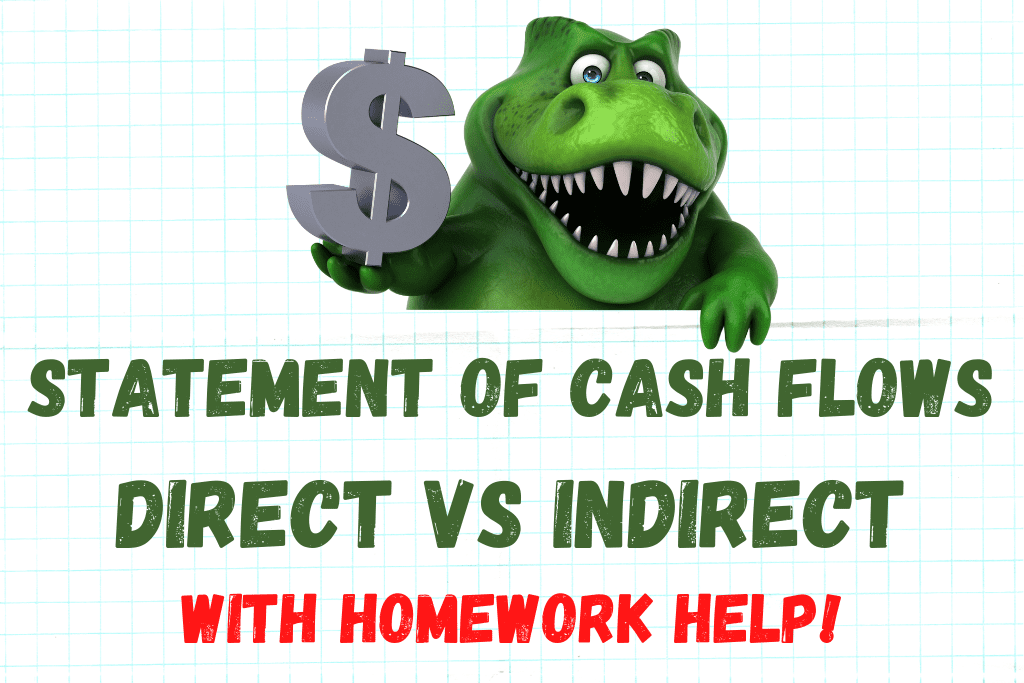
The statement of cash flows is a financial statement that shows how a company’s cash balance changes over time. This statement is divided into three sections: cash flows from operating activities, cash flows from investing activities, and cash flows from financing activities. Two methods can be used to prepare the cash flows from operating activities section: the direct method and the indirect method. Let’s explore both methods and the differences between them.
The Direct Method:
The direct method is a method of preparing the cash flows from operating activities section by showing actual cash inflows and outflows from the company’s operating activities. This means that the accountant will look at the company’s cash receipts from customers, cash paid to suppliers, cash paid for salaries, and other operating expenses, and report them in the cash flows from operating activities section.
The direct method provides more detailed information than the indirect method, as it shows the actual cash received and paid out by the company. However, the direct method is more time-consuming and costly to prepare than the indirect method, as it requires a more detailed analysis of each cash transaction.
The Indirect Method:
The indirect method is a method of preparing the cash flows from operating activities section by adjusting net income to account for non-cash items and changes in working capital. The accountant starts with net income and makes adjustments for depreciation and amortization, changes in accounts receivable, changes in inventory, changes in accounts payable, and other non-cash items.
The indirect method is less detailed than the direct method, but it is more straightforward and less costly to prepare. However, the indirect method may not provide as much insight into the company’s cash flows as the direct method, as it relies on adjustments rather than actual cash inflows and outflows.
Choosing between the Direct Method and the Indirect Method:
The choice between the direct method and the indirect method depends on the size and complexity of the company and the preferences of the accountant. Generally, smaller companies with simpler cash flow structures may use the direct method, while larger companies with more complex cash flow structures may use the indirect method.
Indirect Method Example
Here’s an example of the indirect method for preparing the cash flows from operating activities section of the statement of cash flows for a fictional company, XYZ Corp:
XYZ Corp
Statement of Cash Flows
For the Year Ended December 31, 2024
| XYZ Corp | Net Income | Adjustments to reconcile net income to net cash provided by operating activities |
|---|---|---|
| Net income | $50,000 | |
| Depreciation expense | $25,000 | |
| Increase in accounts receivable | $10,000 | |
| Decrease in inventory | ($15,000) | |
| Increase in accounts payable | ($5,000) | |
| Net cash provided by operating activities | $65,000 |
In this example, XYZ Corp had a net income of $50,000 for the year ended December 31, 2022. To prepare the cash flows from operating activities section using the indirect method, the accountant started with net income and made adjustments to account for non-cash items and changes in working capital.
The first adjustment was to add back the depreciation expense of $25,000, which is a non-cash item that reduces net income but does not affect cash flows.
The second adjustment was to subtract the $10,000 increase in accounts receivable from net income, since this means that the company received $10,000 less in cash from customers than it earned in revenue.
The third adjustment was to add back the $15,000 decrease in inventory to net income, since this means that the company paid $15,000 less in cash to suppliers for inventory than it recorded as an expense.
The final adjustment was to subtract the $5,000 increase in accounts payable from net income, since this means that the company paid $5,000 less in cash to suppliers for inventory than it recorded as an expense.
After making these adjustments, the accountant arrived at a net cash provided by operating activities of $65,000, which represents the actual cash inflows and outflows from the company’s operating activities.
Here’s an example of a cash flows from operating activities section prepared using the direct method:
XYZ Corp
Statement of Cash Flows
For the Year Ended December 31, 2022
| Cash flows from operating activities | |
|---|---|
| Cash received from customers | $300,000 |
| Cash paid to suppliers for inventory | ($150,000) |
| Cash paid to employees | ($75,000) |
| Cash paid for rent and utilities | ($25,000) |
| Cash paid for taxes | ($10,000) |
| Net cash provided by operating activities | $400,000 |
In this example, XYZ Corp had cash receipts from customers of $300,000 during the year ended December 31, 2022. The company paid $150,000 in cash to suppliers for inventory, $75,000 in cash to employees, $25,000 in cash for rent and utilities, and $10,000 in cash for taxes.
To arrive at the net cash provided by operating activities, the accountant simply subtracted the cash outflows from the cash inflows, resulting in net cash provided by operating activities of $40,000.
It’s worth noting that preparing the cash flows from operating activities section using the direct method requires more detailed information on cash receipts and cash payments, which may not be readily available in some cases. As a result, the indirect method is more commonly used in practice.
In conclusion, the direct method and the indirect method are two different approaches to preparing the cash flows from operating activities section of the statement of cash flows. While the direct method provides more detailed information, it is more time-consuming and costly to prepare. The indirect method is less detailed but is more straightforward and less costly to prepare. The choice between the two methods depends on the size and complexity of the company and the preferences of the accountant.
